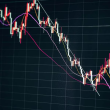by Tom Nakamura, CFA®, VP & Portfolio Manager, Currency Strategy and Co-Head of Fixed Income, & Stephen Way, CFA®, SVP and Head of Global & Emerging Markets Equities, AGF Investments Inc.
The headline on monetary policy for the past year has been straightforward: in response to high inflation, central banks everywhere – the U.S. Federal Reserve, the Bank of Canada and even the European Central Bank, a “pioneer” of negative interest rates even before the pandemic – are in tightening mode. Yet among them there is one significant outlier: the Bank of Japan.
Astonishingly (to some observers, at least), the central bank of the world’s third-largest economy is clinging to so-called yield curve control (YCC), which it first implemented way back in 2016. Today, even as inflation has reached levels not seen in a decade, short-term rates are negative, and the 10-year rate sits well below 0.5%. The BoJ achieves that in two main ways: setting the one-month policy rate at -0.1% at one end of the curve, and on the other end buying huge quantities of long bonds. It’s a sort of quantitative easing on steroids.
In recent months, however, many market observers have begun to question how much longer the Bank of Japan will keep this extraordinary stimulus going. They point to the program’s rising – some might say exorbitant – costs. Inflation ex energy and fresh food – at 3.5% (annualized) in February and 3.2% in January, according to Bloomberg data – is already running very high by Japanese standards. And perhaps the most talked-about harbinger of change is that, as of early April, the BoJ will have a new governor as 79-year-old Haruhiko Kuroda, the steward of YCC, is stepping down after 10 years at the helm. If his successor, Kazuo Ueda, a 71-year-old academic economist and former member of the Bank of Japan’s policy committee, were to weaken the BoJ’s grip on the yield curve, it could have important ramifications for the Japanese economy, as well as bond and currency markets.
Accommodative monetary policy was among the core tenets of so-called Abenomics, the economic reform program introduced in 2012 by then-Japanese Prime Minister Shinzo Abe to stimulate demand and drive inflation, which had been low or negative for years, towards a 2% target. In 2016, the Bank of Japan changed its policy position to “set” the yield on 10-year Japan bonds at zero, while slashing short-term rates into negative territory. Yield curve control was a highly unorthodox move at the time – a radical attempt to banish the spectre of deflation that had haunted Japan for decades. But as the COVID-19 pandemic hit the global economy and other central banks slashed rates, YCC didn’t seem that strange after all. Japan’s unorthodoxy became monetary orthodoxy, to varying degrees.
In the span of a little more than a year, however, a lot changed, and today the BoJ’s reluctance to normalize rates looks increasingly out of place. Curve control has come with significant cost. To keep the 10-year yield within the prescribed band of -0.5% to 0.5% (the band has been widened several times since 2016), the central bank has had to buy bonds on a massive scale. Since December 2022 – when it last widened the band – BoJ bond purchases have totalled more than 10% of the country’s GDP, according to a March 22 report from CLSA, the Hong Kong-based capital markets and investment company, and it now owns more than half of Japan’s roughly US$8-trillion bond market, according to Reuters.
Meanwhile, bond liquidity is drying up. Because of the scale of quantitative easing, Japan’s huge market has become one of the world’s most illiquid, raising concerns in the global investment community that its government bonds might one day become uninvestable. Not that those bonds are very attractive on a relative basis anyway. In mid-March, yield on the Japan 10-year stood at just over 0.3% – about 300 basis points lower than the 10-year U.S. Treasury yield.
Markets seem to have concluded this state of affairs is unsustainable. In recent months, they have put significant pressure on the upper part of the 10-year band. Before Kuroda’s final policy statement in March, speculators – betting that a changing of the guard at the BoJ could lead to a sea-change in policy – even pushed the 10-year yield above 0.5% (briefly, of course). Currency traders have also been testing the waters. Not surprisingly, the yen has generally declined sharply against other currencies since the Fed began raising rates last year, but it has seen sharp spikes since last October, as expectations of a move on YCC have increased.
Of course, those expectations have not turned into reality, at least not yet: the BoJ – and YCC – stood pat this March. But what will Kuroda’s successor do? So far, Ueda has kept his cards close to the chest. He has said that any policy review will take a long time, that monetary policy is not solely responsible for inflation, and that monetary easing needs to continue. Yet there have also been hints that any tightening will come as an intentional surprise to markets; that is, the BoJ won’t let them see it coming. Which, of course, only fuels speculation.
The other side of the YCC coin is that, in important ways, it is having the desired effect on the Japanese economy. Japan has long grappled with deflation, making inflation of 3%-4% – tame, compared to Western economies – something of a welcome development. And given the demographic reality of an old and aging population in Japan, runaway inflation seems a remote risk. Rising prices are also a boon to Japanese workers. Recent settlements with major unions suggest that Japanese workers might at long last be getting meaningful wage increases; Toyota and Honda recently agreed to give employees their biggest pay hikes in decades. Meanwhile, Japan’s export-reliant manufacturers welcome a cheaper yen, as it makes their products more cost-competitive in the global marketplace, and lower rates generally support equity prices.
What would be the impact of unwinding YCC? Markets expect the BoJ to do it by allowing the long end of the yield curve to rise (rather than raising the short-term policy rate), which means that unwinding could take the form of quantitative tightening. It’s unlikely, however, that the BoJ turns immediately to shrinking the balance sheet and, even if the target or band is changed, there could still be buying, just at a different price point. How that could be achieved efficiently, given that the BoJ would be selling bonds on which it has taken a loss, is an open question, but it’s clear that unwinding could roil global bond markets. It could further decrease Japanese demand for foreign securities, which has already been declining in part because of the cost of currency hedging. Australian bonds, in particular, could be hit by a move away from YCC, as Australia has long been a preferred destination for Japanese outward bond investment. The most significant impact, however, could be in currency markets. As Japanese investors repatriate capital, we would expect the yen to surge in the wake of a real move on curve control, which possibly undermines U.S. dollar strength, among other effects.
However, it would make sense for investors to temper expectations for any kind of sudden change from the BoJ. The most likely near-term move is a “tweak” to YCC – for instance, by further expanding the yield band for 10-year bonds and/or by shifting the target to five-year bonds. The BoJ will undoubtedly tread very carefully in letting rates rise, for fear of slowing the economy and jeopardizing reflation. The recent bank meltdowns in the U.S. and Europe and fear of contagion might give Japanese policymakers an excuse to delay—especially if U.S. interest rates are near a peak as a result.
If we had to guess, we would expect any unwinding of YCC to be more of a second-half story than a second-quarter one in 2023. We could be wrong, of course. But one thing is clear: giving up yield curve control is much easier for investors to anticipate than it will be for the Bank of Japan to actually do.
The views expressed in this blog are those of the authors and do not necessarily represent the opinions of AGF, its subsidiaries or any of its affiliated companies, funds, or investment strategies.
Commentary and data sourced Bloomberg, Reuters and company reports unless otherwise noted. The commentaries contained herein are provided as a general source of information based on information available as of April 3, 2023 and are not intended to be comprehensive investment advice applicable to the circumstances of the individual. Every effort has been made to ensure accuracy in these commentaries at the time of publication, however, accuracy cannot be guaranteed. Market conditions may change and AGF Investments accepts no responsibility for individual investment decisions arising from the use or reliance on the information contained here.
This document may contain forward-looking information that reflects our current expectations or forecasts of future events. Forward-looking information is inherently subject to, among other things, risks, uncertainties, and assumptions that could cause actual results to differ materially from those expressed herein.
“Bloomberg®” is a service mark of Bloomberg Finance L.P. and its affiliates, including Bloomberg Index Services Limited (“BISL”) (collectively, “Bloomberg”) and has been licensed for use for certain purposes by AGF Management Limited and its subsidiaries. Bloomberg is not affiliated with AGF Management Limited or its subsidiaries, and Bloomberg does not approve, endorse, review or recommend any products of AGF Management Limited or its subsidiaries. Bloomberg does not guarantee the timeliness, accurateness, or completeness, of any data or information relating to any products of AGF Management Limited or its subsidiaries.
AGF Investments is a group of wholly owned subsidiaries of AGF Management Limited, a Canadian reporting issuer. The subsidiaries included in AGF Investments are AGF Investments Inc. (AGFI), AGF Investments America Inc. (AGFA), AGF Investments LLC (AGFUS) and AGF International Advisors Company Limited (AGFIA). AGFA and AGFUS are registered advisors in the U.S. AGFI is registered as a portfolio manager across Canadian securities commissions. AGFIA is regulated by the Central Bank of Ireland and registered with the Australian Securities & Investments Commission. The subsidiaries that form AGF Investments manage a variety of mandates comprised of equity, fixed income and balanced assets.
® ™ The “AGF” logo and all associated trademarks are registered trademarks or trademarks of AGF Management Limited and used under licence.
RO:20230504-2825994
Copyright © AGF Investments














